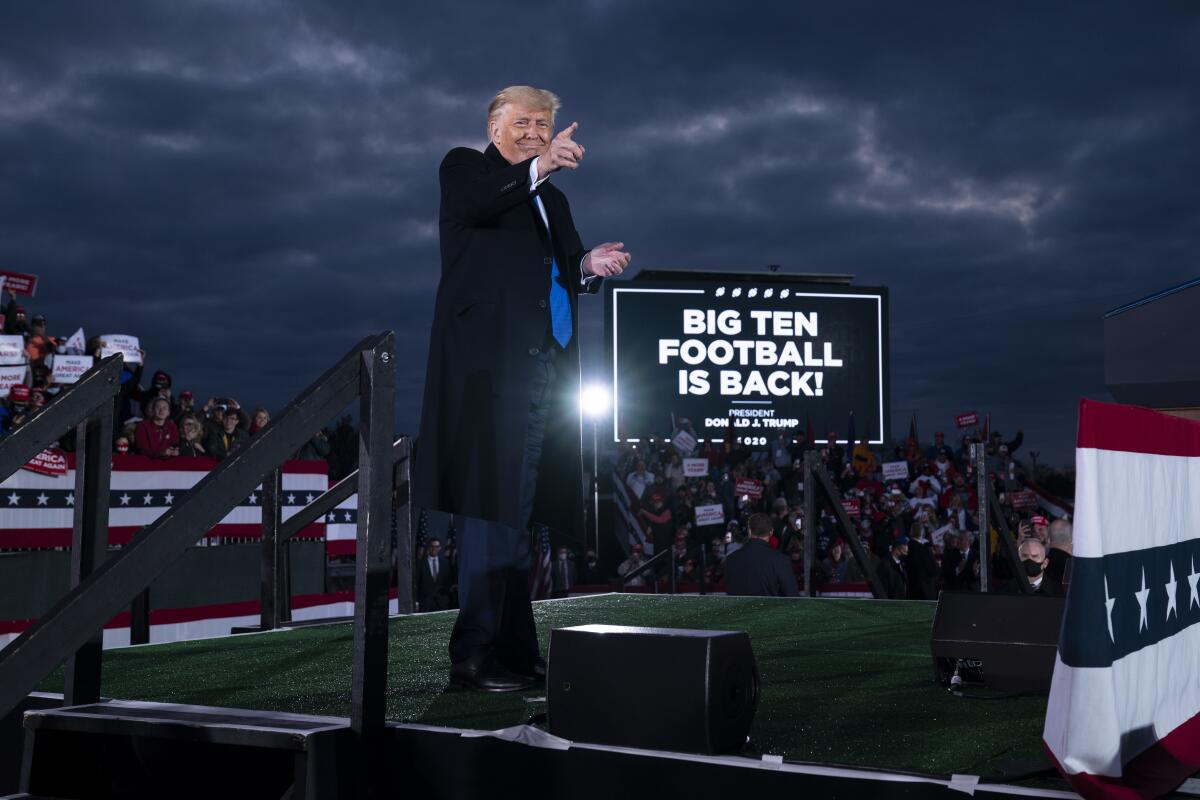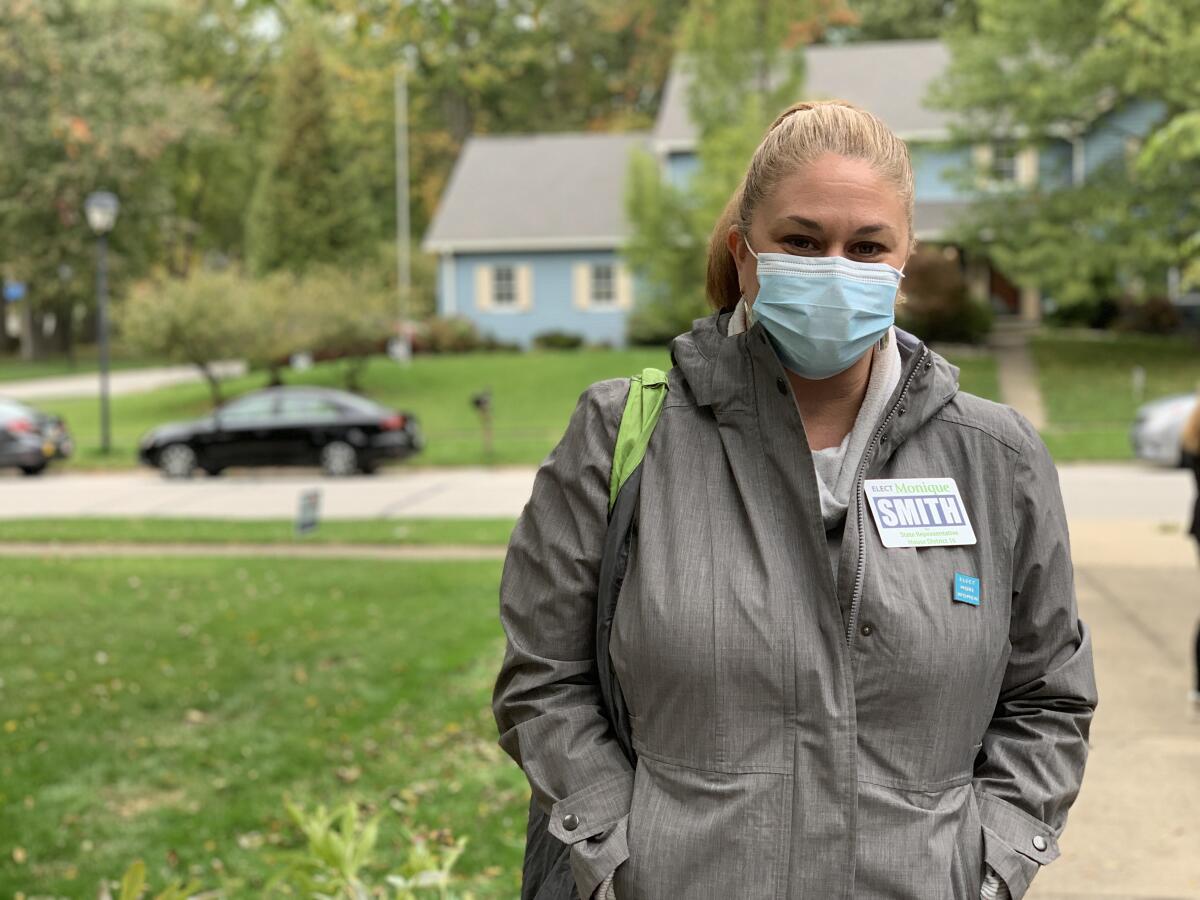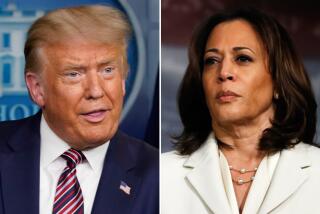Ohio, once seen as Trump territory, emerges as a battleground

- Share via
WESTLAKE, Ohio — For Democrats in Ohio, the recent years have been bleak. President Trump won the Buckeye State by a healthy 8-percentage-point margin in 2016, and two years later the blue wave in the nation’s midterm elections barely made a splash here. Conventional wisdom placed the state firmly outside contention for this year’s presidential race.
Given all that, running for office as a Democrat wouldn’t seem particularly enticing. But Monique Smith kept thinking about the advice from Sen. Sherrod Brown, Ohio’s only Democrat in a statewide office, after the 2018 election: “Pay attention,” he said: Voters in the suburbs are defecting from the Republican Party.
“I had that tucked away in my head,” said Smith, a former City Council member in Lakewood, a suburb west of Cleveland. “I knew my people — the people I know and have worked with and lived with — were disgusted. They were rejecting Trump. That looked promising.”
Now Smith is running for a seat in the state House long held by Republicans but considered a top pickup opportunity for Democrats. And the race in Ohio between Trump and Democratic rival Joe Biden has proved far tighter than predicted, boosting hopes among the party’s candidates down the ballot.
Yet for much of the year, Ohioans have watched as the presidential campaigns mostly focused elsewhere, particularly on the neighboring Midwestern states that proved decisive for Trump four years ago. National Democrats, singed by the presidential losses here in 2004 and 2016, were wary of investing in a state that seemed to be turning red. Republicans felt confident. And Ohioans were courted less than they were used to.
“We’ve asserted our relevance as America’s kingmaker for generations,” said David Niven, professor of political science at the University of Cincinnati. “And now we’re meekly raising our hand in the back and saying, ‘What about us?’”

Lately, the state has seen visits from Trump and Vice President Mike Pence as well as Biden and his running mate, California Sen. Kamala Harris. Television ad spending, particularly by Biden and allied groups, has surged in the last month. On Wednesday, former New York Mayor Michael R. Bloomberg began an eleventh-hour $5-million spending blitz in Ohio.
Even as Ohio reemerges as a swing state, the political landscape has changed. Republicans are on their heels in traditionally red suburbs like Smith’s, and on offense in onetime Democratic strongholds like the working-class Mahoning Valley, in the struggling industrial northeast. It’s a realignment that Trump has spurred.
Route 46 in Canfield, just outside Youngstown and once the heart of solid-blue territory, is now known as “Trump Highway,” where devoted fans of the president hold impromptu roadside tailgate gatherings, waving flags and cheering at passing cars.
Chris Stanley, driving by on a recent weekend in his pickup truck, sighed at the sight. He knows he has to win over some Trump voters to unseat state Rep. Al Cutrona, a young Republican lawyer. (Cutrona declined to be interviewed.) The legislative district had long been in Democratic hands, until 2018, yet now Stanley’s party affiliation could be his biggest disadvantage.
“The problem I’m running into is that I have a D at the end of my name,” said Stanley, a 40-year-old social studies teacher. “If I had an R at the end of my name and I was talking about the exact same stuff I’m talking about, the Republicans would love me.”
Weeks ago, Stanley thought Biden didn’t have a chance in the state, making his own run even more of an uphill slog. Then he saw more Biden yard signs, and conservative friends started to express queasiness with the president’s behavior.
“I think calling Ohio a toss-up — a flip of the coin — is accurate,” he said.
The area’s Trump fans disagree.
“I don’t think Biden has a chance,” said Geno DiFabio, a truck driver from Youngstown, at an outdoor Halloween party put on by local Republicans. When DiFabio, a quintessential blue-collar Democrat turned diehard Trump fan, was featured on Fox News, he caught the eye of the TV-obsessed president, who invited him onstage at a 2017 rally in Youngstown. The audio of Trump introducing him is now DiFabio’s cellphone ringtone.
DiFabio is not the kind of voter Democrats are likely to win back. He said the local economy suffered a “slow bleed” in the decades after the North American Free Trade Agreement took effect in 1994, but “Trump came in and cut taxes, cut regulation.” Before the pandemic, he said, “everyone was working.”
But Democrats point to a more troubled picture — the closing of the GM plant in nearby Lordstown, contrary to Trump’s promises, as well as his mishandling of the pandemic — and hope that a centrist like Biden can claw back at least some of the lost voters.
“I do think Biden is a good candidate for Democrats in this area because he’s something of a throwback,” said Paul Sracic, a political science professor at Youngstown State University. “These are not ‘the Squad’ Democrats,” he added, referring to a group of progressive women of color in Congress whom Trump likes to assail as the “socialist” face of the party. “They are more moderate, old-fashioned, socially conservative.”
Rep. Tim Ryan, the Democrat who represents the area in Congress, said he sensed movement well before the polls showed the race tightening. Before the first presidential debate, in Cleveland late last month, Biden called him about the outlook in the state.
“Shoot straight with me,” Biden said, in Ryan’s telling.
“You can do it,” the congressman told him.
The Biden campaign since has upped its spending and presence in Ohio, even as the Trump team has sent mixed signals on how zealously they’re defending the state.
The president boasted on a call to campaign staff last week that he did not need to visit Ohio because he had it locked up, according to Politico. Days later, however, he rallied thousands of supporters outside Columbus. His campaign, which has less money on hand than Biden’s, cut TV ad spending but has a more aggressive field campaign than Democrats, who are wary of face-to-face politicking in a pandemic.
“The campaign has been active and on the ground longer than Biden’s campaign has, and more organized. That does count for something,” said Lisa Stickan, the Republican Party chair in Cuyahoga County, which includes Cleveland.
David Pepper, the state Democratic Party chair, takes heart that Trump has had to spend any resources or time at all in a state he won handily in 2016. “That’s the definition of losing — regardless of the outcome — that they have to sweat it out in Ohio,” Pepper said.
Few analysts consider Ohio to be a “tipping point” state — the clincher for either candidate to win the electoral college vote. But beyond the importance of its 18 electoral votes, a show of strength here could ripple across the country’s most contested region.
“Ohio dictates where the Midwest ends up,” said Mike Hartley, a Republican strategist based in Columbus. “If Trump wins Ohio by 6 to 8 points, it will carry over into Michigan, Pennsylvania and Wisconsin. If Biden wins Ohio, that means he wins those states.”
State Rep. Dave Greenspan, the Republican being challenged by Monique
Smith in suburban Cleveland, believes his fate depends on whether he can decouple his race from Trump’s.
He’s done it before — in 2016, he won his seat handily even as Clinton narrowly beat Trump in the district. Two years later, Greenspan won again, albeit with half the margin against a barely funded opponent. Democrats, meanwhile, netted five state House seats in 2018, largely in suburban districts like his.

He’s hoping that Republicans who stayed home in 2018 will be back out in force, and that voters overall will support him for his service if not his party affiliation.
“I’m a moderate. I call myself a practical conservative,” said Greenspan, 55. “They understand my No. 1 responsibility is to look out for them.”
He didn’t want to talk about Trump; he said the race is about local issues.
Smith, out talking to voters on a rainy Sunday, also said little about the presidential race. Instead, she’s painted Greenspan as too conservative, pointing to his vote, for example, to ban abortion after six weeks of pregnancy.
Still, Smith prominently touts an endorsement from Biden on her website. As she prepared to distribute campaign literature in Westlake, in the most conservative part of the district, she happily handed over a Biden lawn sign to Aggie Howard, out for a stroll with her dog.
Howard, 79, an independent who wrote in the name of then-Gov. John Kasich, a Republican, for president in 2016, said she is so disgusted with Trump’s handling of the pandemic that she plans to reject his party entirely: “I don’t care who’s running. I’m voting straight Democrat.”
It is voters like Howard, and the purple turn of Ohio’s once-red suburbs, that explain the final flurry of campaign activity.
“We’ve always been in play,” said Shontel Brown, chair of the Cuyahoga County Democrats. “It’s just good to know that everyone else is finally recognizing that again.”
More to Read
Get the L.A. Times Politics newsletter
Deeply reported insights into legislation, politics and policy from Sacramento, Washington and beyond. In your inbox three times per week.
You may occasionally receive promotional content from the Los Angeles Times.











